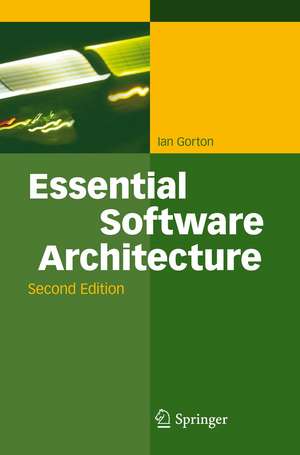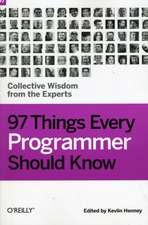Essential Software Architecture
Autor Ian Gortonen Limba Engleză Paperback – 8 oct 2014
Gorton’s book tries to resolve this dilemma. It concisely describes the essential elements of knowledge and key skills required to be a software architect. The explanations encompass the essentials of architecture thinking, practices, and supporting technologies. They range from a general understanding of structure and quality attributes through technical issues like middleware components and service-oriented architectures to recent technologies like model-driven architecture, software product lines, aspect-oriented design, and the Semantic Web, which will presumably influence future software systems. This second edition contains new material covering enterprise architecture, agile development, enterprise service bus technologies, RESTful Web services, and a case study on how to use the MeDICi integration framework.
All approaches are illustrated by an ongoing real-world example. So if you work as an architect or senior designer (or want to someday), or if you are a student in software engineering, here is a valuable and yet approachable knowledge source for you.
| Toate formatele și edițiile | Preț | Express |
|---|---|---|
| Paperback (1) | 330.56 lei 6-8 săpt. | |
| Springer Berlin, Heidelberg – 8 oct 2014 | 330.56 lei 6-8 săpt. | |
| Hardback (1) | 479.30 lei 6-8 săpt. | |
| Springer Berlin, Heidelberg – 6 mai 2011 | 479.30 lei 6-8 săpt. |
Preț: 330.56 lei
Preț vechi: 413.21 lei
-20% Nou
Puncte Express: 496
Preț estimativ în valută:
63.27€ • 68.75$ • 53.18£
63.27€ • 68.75$ • 53.18£
Carte tipărită la comandă
Livrare economică 21 aprilie-05 mai
Preluare comenzi: 021 569.72.76
Specificații
ISBN-13: 9783642435317
ISBN-10: 3642435319
Pagini: 260
Ilustrații: XVI, 242 p.
Dimensiuni: 155 x 235 x 14 mm
Greutate: 0.37 kg
Ediția:2nd ed. 2011
Editura: Springer Berlin, Heidelberg
Colecția Springer
Locul publicării:Berlin, Heidelberg, Germany
ISBN-10: 3642435319
Pagini: 260
Ilustrații: XVI, 242 p.
Dimensiuni: 155 x 235 x 14 mm
Greutate: 0.37 kg
Ediția:2nd ed. 2011
Editura: Springer Berlin, Heidelberg
Colecția Springer
Locul publicării:Berlin, Heidelberg, Germany
Public țintă
Professional/practitionerCuprins
Understanding Software Architecture.- Introducing the Case Study.- Software Quality Attributes.- An Introduction to Middleware Architectures and Technologies.- Service-Oriented Architectures and Technologies.- Advanced Middleware Technologies.- A Software Architecture Process.- Documenting a Software Architecture.- Case Study Design.- Middleware Case Study: MeDICi.- Looking Forward.- The Semantic Web.- Aspect Oriented Architectures.- Model-Driven Architecture.- Software Product Lines.-
Recenzii
From the reviews of the second edition:
Choice - Oustanding Academic Title in 2012
“The volume is organized in three main parts, the first of which provides a comprehensive but clear definition of software architecture. The second and third parts are devoted to current and emerging practices, respectively. … This book will be of great help to students of computer science or software engineering, but above all it will provide practitioners with a guide to architecture that they can adopt to help direct their careers and professional development. Summing Up: Highly recommended. Upper-division undergraduates and above.” (L. Benedicenti, Choice, Vol. 49 (5), January, 2012)
“A subset of the software system architecture discipline is discussed in this book. … Gorton begins with an overall description of what he calls ‘the subdiscipline known as software architecture.’ … useful in the technical library of a large financial institution for those engaged in major systems development and evolution.” (Mordechai Ben-Menachem, ACM Computing Reviews, January, 2012)
Choice - Oustanding Academic Title in 2012
“The volume is organized in three main parts, the first of which provides a comprehensive but clear definition of software architecture. The second and third parts are devoted to current and emerging practices, respectively. … This book will be of great help to students of computer science or software engineering, but above all it will provide practitioners with a guide to architecture that they can adopt to help direct their careers and professional development. Summing Up: Highly recommended. Upper-division undergraduates and above.” (L. Benedicenti, Choice, Vol. 49 (5), January, 2012)
“A subset of the software system architecture discipline is discussed in this book. … Gorton begins with an overall description of what he calls ‘the subdiscipline known as software architecture.’ … useful in the technical library of a large financial institution for those engaged in major systems development and evolution.” (Mordechai Ben-Menachem, ACM Computing Reviews, January, 2012)
Notă biografică
Ian Gorton is a Laboratory Fellow at the Pacific Northwest National Lab in Washington State, USA. He leads multiple projects that create advanced tools and reusable architectures for use in scientific and data analysis applications. Prior to this, he was a member of the Empirical Software Engineering group at National ICT Australia (NICTA), based in Sydney, Australia. In over 20 years of experience, Ian has worked in both academia and industry, and held various senior positions, including Chief Architect, in Government research labs in Australia and the USA. He has also consulted to major organizations including Fujitsu, Borland, the Australian Stock Exchange, IBM and the Australian Tax office, and served as Program Chair for both WICSA and COMPARCH, the two leading international conferences in Software Architecture.
"I'm basically a software {architect, researcher, engineer}. I work on a whole range of projects, including new middleware technology R&D, designing architectures for enterprise applications, and carrying out software architecture research. I guess I must enjoy the variety!"
"I'm basically a software {architect, researcher, engineer}. I work on a whole range of projects, including new middleware technology R&D, designing architectures for enterprise applications, and carrying out software architecture research. I guess I must enjoy the variety!"
Textul de pe ultima copertă
Job titles like “Technical Architect” and “Chief Architect” nowadays abound in software industry, yet many people suspect that “architecture” is one of the most overused and least understood terms in professional software development.
Gorton’s book tries to resolve this dilemma. It concisely describes the essential elements of knowledge and key skills required to be a software architect. The explanations encompass the essentials of architecture thinking, practices, and supporting technologies. They range from a general understanding of structure and quality attributes through technical issues like middleware components and service-oriented architectures to recent technologies like model-driven architecture, software product lines, aspect-oriented design, and the Semantic Web, which will presumably influence future software systems. This second edition contains new material covering enterprise architecture, agile development, enterprise service bus technologies, RESTful Web services, and a case study on how to use the MeDICi integration framework.
All approaches are illustrated by an ongoing real-world example. So if you work as an architect or senior designer (or want to someday), or if you are a student in software engineering, here is a valuable and yet approachable knowledge source for you.
Gorton’s book tries to resolve this dilemma. It concisely describes the essential elements of knowledge and key skills required to be a software architect. The explanations encompass the essentials of architecture thinking, practices, and supporting technologies. They range from a general understanding of structure and quality attributes through technical issues like middleware components and service-oriented architectures to recent technologies like model-driven architecture, software product lines, aspect-oriented design, and the Semantic Web, which will presumably influence future software systems. This second edition contains new material covering enterprise architecture, agile development, enterprise service bus technologies, RESTful Web services, and a case study on how to use the MeDICi integration framework.
All approaches are illustrated by an ongoing real-world example. So if you work as an architect or senior designer (or want to someday), or if you are a student in software engineering, here is a valuable and yet approachable knowledge source for you.
Caracteristici
Provides clear and concise information about methods and techniques for architectural best-practice in IT systems Describes and analyses component and middleware technologies that support fundamental architectural patterns in enterprise systems Looks forward to how recent and emerging technologies like SOA, MDA, AOD, and software product lines may affect the next generation of enterprise information system architectures Uses real-world examples from banking, e-commerce, and government information systems to explain methods and technologies Provides many pointers and references to further work on software architecture Includes supplementary material: sn.pub/extras














